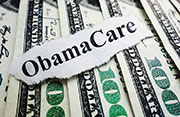
WEDNESDAY, May 7, 2014 (HealthDay News) — A significant majority of Americans who signed up for health insurance under the Affordable Care Act have completed the final step of enrollment by paying their first month’s premium, insurers will tell a Congressional committee on Wednesday.
In written testimony, several of the nation’s largest insurance companies said many people are successfully paying their premiums, with payment rates running between 70 percent and 90 percent, depending on the company and the state. Consumers who bought policies with later effective dates may not have paid yet because they haven’t received a bill, the insurers said.
The U.S. House Energy and Commerce Subcommittee on Oversight and Investigations will hear from several members of the insurance industry during a hearing on the Affordable Care Act’s marketplaces and enrollments.
The Affordable Care Act is the controversial 2010 legislation that requires most Americans to have health insurance or pay a fine in the form of a tax penalty. Considered President Barack Obama’s most visible domestic achievement, it is intended to bring insurance coverage to an estimated 30 million Americans with no coverage. It is also widely unpopular with Republican lawmakers.
Mark Pratt, senior vice president of state affairs at America’s Health Insurance Plans, a Washington, D.C.-based insurance industry group, said there’s still some uncertainty surrounding paid enrollments.
Some insurers “voluntarily decided to provide flexibility in the deadline by which exchange enrollees must pay their first month’s premium,” Pratt said in written testimony. In some cases, enrollees created duplicative accounts or decided to terminate their online enrollments, adding to the difficulty of calculating accurate enrollment numbers and payment rates, he said.
The U.S. Department of Health and Human Services recently reported that 8 million Americans had signed up for health insurance on the federal and state online marketplaces during the 2014 open enrollment period.
The marketplaces, or exchanges, were created to help consumers enroll in private health plans offered under the Affordable Care Act, or Obamacare, as some people know it.
The Obama administration has not been able to say how many health-plan enrollments are paid up.
Last week, the Republican-led House Energy and Commerce Committee reported data suggesting that only two-thirds of people who signed up through the federal HealthCare.gov website had paid their premiums as of April 15. The committee has since asked insurers to provide an update on paid enrollments as of May 20.
Because paid enrollments are constantly changing “it may be a matter of months before system-wide numbers on premium payments are available,” Pratt said.
At Aetna Inc., the payment rate “has been in the low- to mid- 80 percent range,” said Paul Wingle, executive director of the individual business and public exchange operations and strategy. Aetna participates in insurance marketplaces in 17 states.
WellPoint Inc., which offers health plans in eight states through HealthCare.gov and several state-based exchanges, has seen premium payment rates as high as 90 percent, depending on the state, said Dennis Matheis, president of WellPoint’s central region and exchange strategy. For all applicants, the payment rate is roughly 70 percent, he said.
Health Care Service Corp. (HCSC), which operates Blue Cross and Blue Shield plans in five states, reported payment rates in the mid- to high-80 percent range for policies with effective dates starting between Jan. 1 and April 1, 2014.
Darren Rodgers, HCSC’s senior vice president and chief marketing officer, explained that “applicants with policies with an effective date of May 1 may still have time remaining in the payment deadline.” Only 68 percent of those policies have been paid, he said.
Brian Evanko, president of the U.S. individual segment at Cigna Corp., did not disclose specific payment rates in his written testimony. The company offers marketplace plans in just five states, four of which use the HealthCare.gov website.
Cigna entered the exchanges “on a focused basis in 2014,” in part, “to gather deeper learning about consumer behaviors in the individual market,” he said.
The first open enrollment period for insurance coverage under Obamacare ended March 31, with some consumers getting extra time to complete their enrollments.
Most Americans won’t have another chance to sign up for coverage through the exchanges until the next open enrollment period, which begins Nov. 15. Coverage purchased during that time won’t take effect until 2015.
More information
Learn more about the health-care marketplaces at HealthCare.gov.
Copyright © 2025 HealthDay. All rights reserved.
